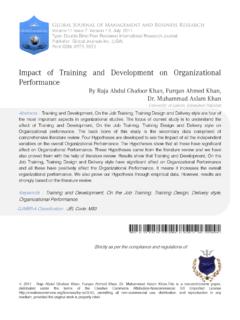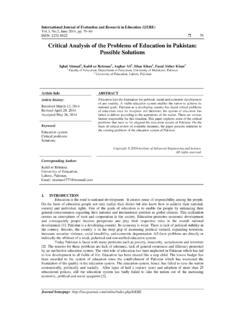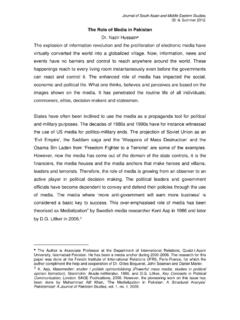Transcription of Structural functionalism - FACULTY PORTAL
1 Structural functionalism1 Structural functionalismStructural functionalism , or in many contexts simply functionalism , is a broad perspective in sociology andanthropology which sets out to interpret society as a structure with interrelated parts. functionalism addressessociety as a whole in terms of the function of its constituent elements; namely norms, customs, traditions andinstitutions. A common analogy, popularized by Herbert Spencer, presents these parts of society as "organs" thatwork toward the proper functioning of the "body" as a whole.[1] In the most basic terms, it simply emphasises "theeffort to impute, as rigorously as possible, to each feature, custom, or practice, its effect on the functioning of asupposedly stable, cohesive system."[2] For Talcott Parsons, " functionalism " came to describe a particular stage inthe methodological development of social science, rather than a specific school of thought.
2 [3]TheoryThe functionalist approach was implicit in the thought of the original sociological positivist, Auguste Comte, whostressed the need for cohesion after the social malaise of the French Revolution. It was later presented in the work of mile Durkheim, who developed a full theory of organic solidarity, again informed by positivism, or the quest for"social facts". functionalism shares a history and theoretical affinity with the empirical method. Latter sociologicalfunctionalists such as Niklas Luhmann and Talcott Parsons, however, can be viewed as at least partiallyantipositivist.[2] Whilst one may regard functionalism as a logical extension of the organic analogies for societypresented by political philosophers such as Rousseau, sociology draws firmer attention to those institutions unique toindustrialised capitalist society (or modernity).
3 functionalism also has an anthropological basis in the work oftheorists such as Marcel Mauss, Bronis aw Malinowski and Radcliffe-Brown. It is in Radcliffe-Brown's specificusage that the prefix ' Structural ' emerged.[4]Classical functionalist theories are defined by a tendency towards biological analogy and notions of socialevolutionism:Functionalist thought, from Comte onwards, has looked particularly towards biology as the science providingthe closest and most compatible model for social science. Biology has been taken to provide a guide toconceptualizing the structure and the function of social systems and to analysing processes of evolution viamechanisms of adaptation .. functionalism strongly emphasises the pre-eminence of the social world over itsindividual parts ( its constituent actors, human subjects).
4 Anthony Giddens The Constitution of Society 1984, [5] Structural functionalism2 mile DurkheimDurkheim proposed that most stateless, "primitive" societies,lacking strong centralised institutions, are based on an associationof corporate-descent groups. Structural functionalism also took onMalinowski's argument that the basic building block of society isthe nuclear family, and that the clan is an outgrowth, not viceversa. Durkheim was concerned with the question of how certainsocieties maintain internal stability and survive over time. Heproposed that such societies tend to be segmented, with equivalentparts held together by shared values, common symbols or, as hisnephew Marcel Mauss held, systems of exchanges. In modern,complicated societies, members perform very different tasks,resulting in a strong interdependence.
5 Based on the metaphorabove of an organism in which many parts function together tosustain the whole, Durkheim argued that complicated societies areheld together by organic views were upheld by Radcliffe-Brown, who, followingComte, believed that society constitutes a separate "level" ofreality, distinct from both biological and inorganic of social phenomena had therefore to be constructedwithin this level, individuals being merely transient occupants of comparatively stable social roles. The centralconcern of Structural functionalism is a continuation of the Durkheimian task of explaining the apparent stability andinternal cohesion needed by societies to endure over time. Societies are seen as coherent, bounded andfundamentally relational constructs that function like organisms, with their various parts (or social institutions)working together in an unconscious, quasi-automatic fashion toward achieving an overall social equilibrium.
6 Allsocial and cultural phenomena are therefore seen as functional in the sense of working together, and are effectivelydeemed to have "lives" of their own. They are primarily analyzed in terms of this function. The individual issignificant not in and of himself but rather in terms of his status, his position in patterns of social relations, and thebehaviours associated with his status. The social structure, then, is the network of statuses connected by is simplistic to equate the perspective directly with political conservativism.[6] The tendency to emphasise"cohesive systems", however, leads functionalist theories to be contrasted with "conflict theories" which insteademphasise social problems and of functionalismStructural functionalism reached its crescendo in the 1940s and 1950s, and by the 1960s was in rapid decline.
7 [7] By1980s, its place was taken in Europe by more conflict-oriented approaches[8] , and more recently by 'structuralism'.[9]While some of the critical approaches also gained popularity in the United States, the mainstream of the disciplinehas instead shifted to a miriad of empirically-oriented middle-range theories with no overarching theoreticalorientation. To most sociologists, functionalism is now "as dead as a dodo".[10]As the influence of both functionalism and Marxism in the 1960s began to wane, the linguistic and cultural turns ledto myriad new movements in the social sciences: "According to Giddens, the orthodox consensus terminated in thelate 1960s and 1970s as the middle ground shared by otherwise competing perspectives gave way and was replacedby a baffling variety of competing perspectives. This third 'generation' of social theory includes phenomenologicallyinspired approaches, critical theory, ethnomethodology, symbolic interactionism, structuralism, post-structuralism,and theories written in the tradition of hermeneutics and ordinary language philosophy.
8 "[11] Structural functionalism3 While absent from empirical sociology, functionalist themes remained detectable in sociological theory, mostnotably in the works of Luhmann and Giddens. There are, however, signs of an incipient revival, as functionalistclaims have recently been bolstered by developments in multilevel selection theory and in empirical research on howgroups solve social dilemmas. Recent developments in evolutionary theory especially by biologist David SloanWilson and anthropologists Robert Boyd and Peter Richerson have provided strong support for structuralfunctionalism in the form of multilevel selection theory. In this theory, culture and social structure are seen as aDarwinian (biological or cultural) adaptation at the group TheoristsHerbert SpencerHerbert SpencerHerbert Spencer, a British philosopher famous for applying thetheory of natural selection to society, was in many ways the firsttrue sociological functionalist;[12] in fact, while Durkheim iswidely considered the most important functionalist amongpositivist theorists, it is well known that much of his analysis wasculled from reading Spencer's work, especially his Principles ofSociology (1874-96).
9 While most avoid the tedious task of reading Spencer's massivevolumes (filled as they are with long passages explicating theorganic analogy, with reference to cells, simple organisms,animals, humans and society), there are some important insightsthat have quietly influenced many contemporary theorists,including Talcott Parsons, in his early work "The Structure ofSocial Action" (1937), Cultural anthropology, too, usesfunctionalism evolutionary model, unlike most Nineteenth-Centuryevolutionary theories, is cyclical, beginning with thedifferentiation and increasing complication of an organic or"super-organic" (Spencer's term for a social system) body,followed by a fluctuating state of equilibrium and disequilibrium(or a state of adjustment and adaptation), and, finally, a stage of disintegration or dissolution.
10 Following ThomasMalthus' population principles, Spencer concluded that society is constantly facing selection pressures (internal andexternal) that force it to adapt its internal structure through solution, however, causes a new set of selection pressures that threaten society's viability. It should be notedthat Spencer was not a determinist in the sense that he never said pressures will be felt in time to change them; will be felt and reacted to; solutions will always fact, he was in many ways a political sociologist,[13] and recognised that the degree of centralised andconsolidated authority in a given polity could make or break its ability to adapt. In other words, he saw a generaltrend towards the centralisation of power as leading to stagnation and, ultimately, pressure to specifically, Spencer recognised three functional needs or prerequisites that produce selection pressures: theyare regulatory, operative (production) and distributive.








